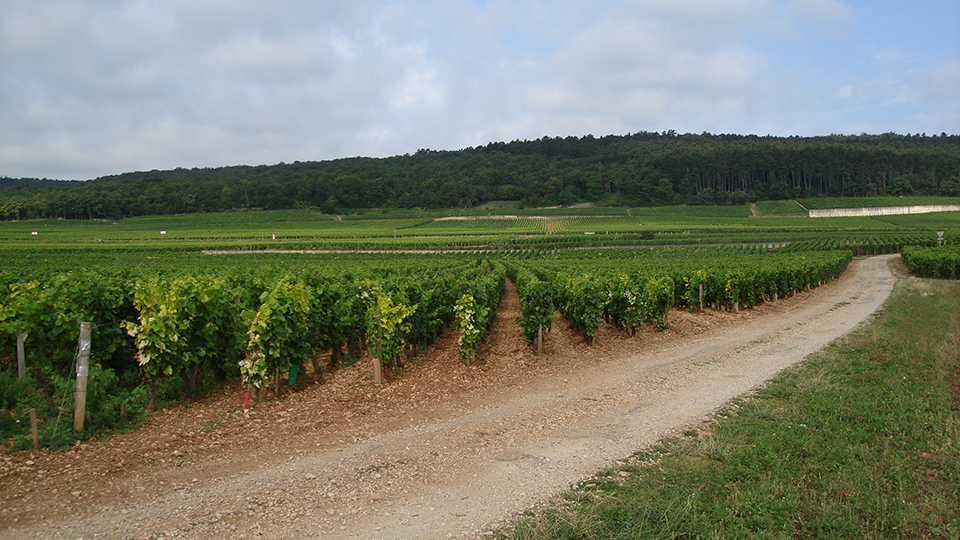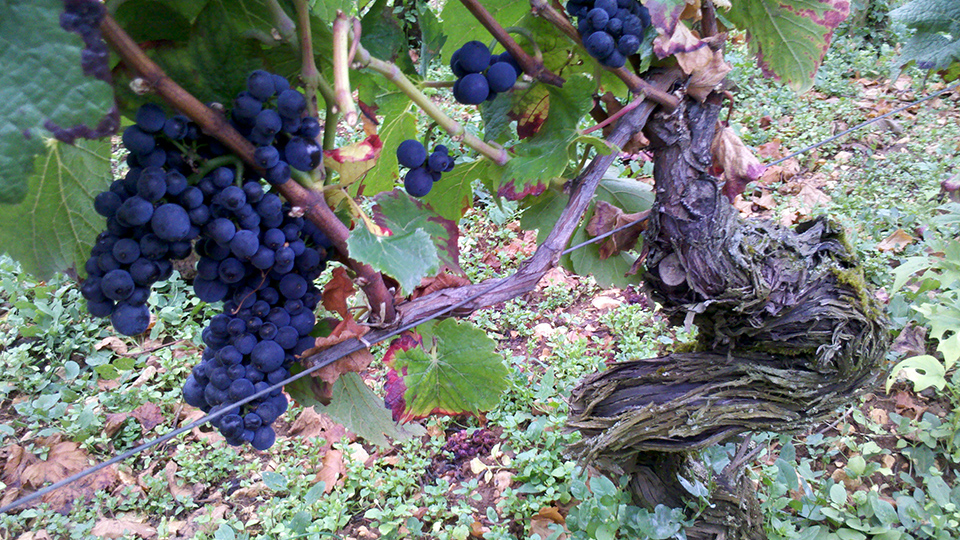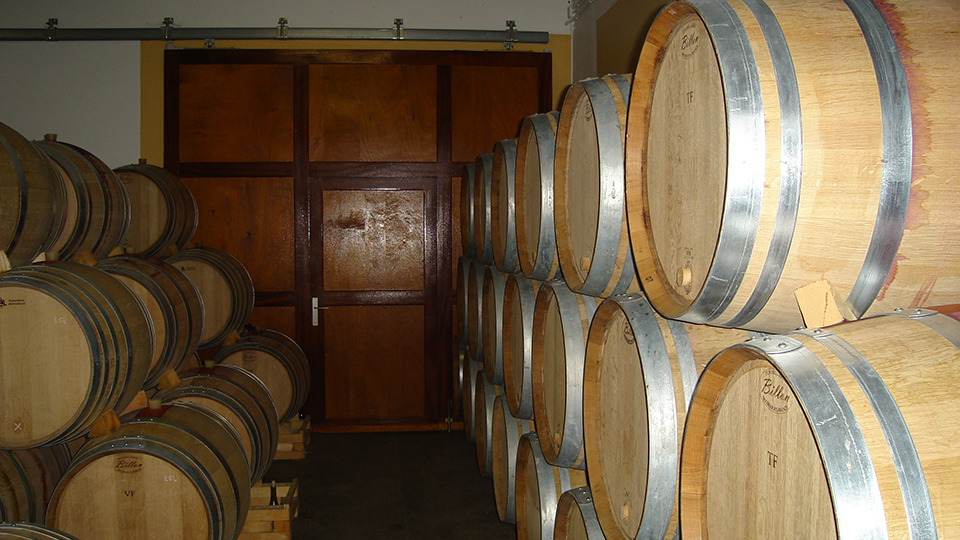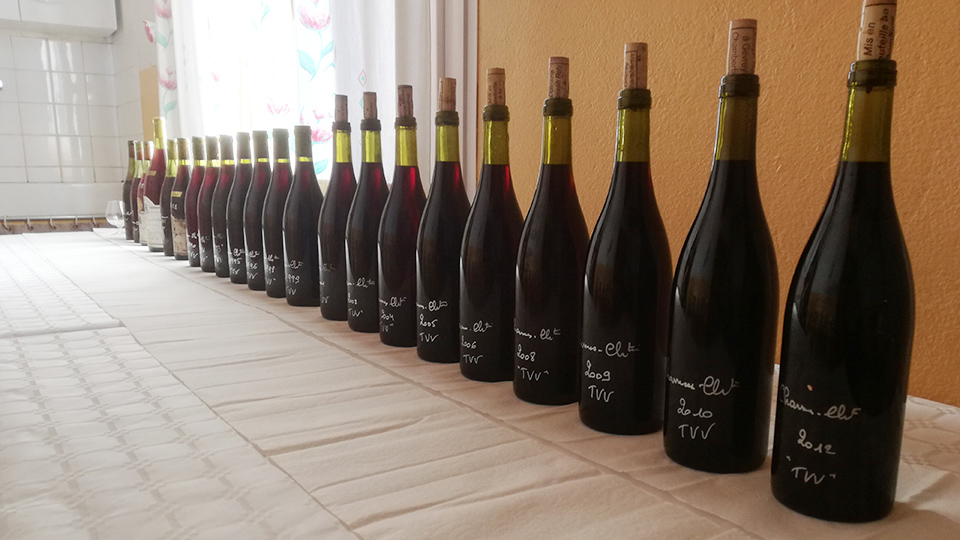Browse using the new Vinous website now. Launch →
Printed by, and for the sole use of . All rights reserved © 2015 Vinous Media
Domaine Joseph Roty’s Charmes-Chambertin Cuvée de “Très Vieilles Vignes”
BY STEPHEN TANZER | FEBRUARY 28, 2019
Full disclosure: I may have a genetic susceptibility to the wines of Domaine Joseph Roty, particularly their marvelous Charmes-Chambertin. In fact, I have more bottles of Roty’s Charmes-Chambertin Cuvée de “Très Vieilles Vignes” in my cellar than any other Burgundy, and they rarely disappoint. My extensive vertical tasting of this bottling in December was also a celebration of a very private family—and the ghost in the room was the formidable personality of the late Joseph Roty, who was largely responsible for creating the “Roty style.”

View of the Roty Charmes-Chambertin
The Challenge of Tasting Chez Roty
For a good 25 years now, I’ve been tasting barrel samples and new releases from Roty in a room at the back of the garage-like barrel cellar attached to their house in Gevrey-Chambertin. The tasting room looks out onto their piece of the lieu-dit Gevrey-Chambertin La Brunelle—but I seldom see the vines because I routinely arrive late on a November afternoon, well after sunset. A tasting of two vintages from barrel and bottle here is inevitably a marathon, involving nearly three dozen samples, for the Rotys have always presented a full line-up of their wines, beginning with multiple Bourgogne rouge and Marsannay bottlings. With only a half-hearted heater cycling on and off to temper the room’s chill–and invariably a plate of piping-hot gougères brought in by Madame Roty halfway through the tasting—I taste here well into the evening.
I was lucky enough to be accepted by the visitor-shy Rotys early on, and through the decade of the 1990s I tasted annually with garrulous Joseph himself. He was one of the more entertaining characters I’ve met in the wine business. Roty was variously described as an iconoclast, an enfant terrible, a recluse and even a paranoid, all of these characteristics softened by his sardonic sense of humor and casual self-presentation (comfy overalls, extensive facial hair, and perpetually burning cigarette, even during our tastings). Yes, tasting with Roty was a challenge. His protean patter—about his stamp collection, his family, military history, current French politics, winemaking colleagues in Gevrey-Chambertin—could be distracting, but his powerful wines had a way of making you sit up and focus. Interestingly, while he was always expansive on a wide range of subjects, Roty tended to clam up on questions of winemaking and élevage—even on the topic of his own vineyard holdings. Then too, during the dozen or so years I tasted with him he was apt to provide different answers to the same technical questions. That was also part of the Roty style.

An ancient vine in Charmes-Chambertin
The Roty Family’s Long History in Gevrey-Chambertin
The Rotys are among the oldest winemaking families in Gevrey-Chambertin: the family estate has existed since 1710 and they have owned and farmed vines in the village since 1817. Today, the Rotys control about 15 hectares of vines, and current winemaker Pierre-Jean Roty represents the 11th generation of Rotys in Gevrey-Chambertin. But I should note that back in the autumn of 1996, Roty told me that he had actually traced his lineage back 14 generations to Philibert Roty, who made wine under the reign of (“the Good King”) Henry IV, who was assassinated in 1610.
The Roty family has dealt with tragedy in the early years of the 21st century. Joseph, who took over the domaine from his paternal grandfather Charles Roty in 1968 (Joseph’s father had died at the age of 35), was a long-time chain smoker, and after having been in declining health for several years he died in 2008. His oldest son Philippe, who had worked with his father since 1990 and had already assumed primary responsibility for winemaking by the time of his father’s death, officially took the reins but was diagnosed with pancreatic cancer in 2012 and after a valiant battle passed away at the age of 46, just following the harvest of 2015. For several years, Philippe had made a number of wines under his own Philippe Roty label but after his death his vineyards were consolidated under the Domaine Joseph Roty umbrella.
Philippe’s younger brother Pierre-Jean, who had worked with both his brother and his father since 2001, took over responsibility for the vineyards and winemaking from Philippe.

First-year barrels in the Domaine Roty cellar
Some of the Oldest Vines in Burgundy
The Roty holding in Charmes-Chambertin includes three parcels at essentially the same altitude comprising about half a hectare in the heart of the cru (Aux Charmes), downslope from Chambertin—i.e., not in the lesser Mazoyères-Chambertin. The vines date back to 1881 and 1882, making them some of the oldest on the Côte d’Or. Phylloxera arrived here in the 1860s, according to Pierre-Jean Roty, and it took the region nearly 20 years to figure out that the solution was to graft the vines onto phylloxera-resistant American rootstock. The vines were originally planted en foule (in a crowd) and at that time they were pruned en gobelet, without supporting wires (this old method was popular during the late 19th century). As the vines were planted in staggered rows, they gave an impression of disorder, with a density of about 11,500 plants per hectare: between 0.75 and 0.8 meter between vines and 0.8 and 1.1 meter between rows, or just enough room to work the vines with a man and a horse). Later on, as the vines were aligned with wires and posts, some of them had to be uprooted. Today the vines are pruned using the single guyot method (essentially cane pruning) commonly employed in Burgundy and other cool wine regions.
The family has never used pesticides or chemical fertilizers in their vines (they add humus and compost to “dynamise” the soil, according to Pierre-Jean), prunes their vines short, and has always eliminated the surface roots in order to force the main roots deep into the soil and underlying chalk and rock. And thus a good portion of the oldest vines—as much as 60% of them, according to Patricia Rainho-Roty, who co-manages the estate with her mother Françoise and brother Pierre-Jean—are still alive and producing surprisingly decent crop levels. Until the early 1980s, any missing vines were replaced with grafts using a diverse sélection massale (in the ‘90s, Joseph Roty told me that “a clone is a monster: it’s against nature”) but more recently the Rotys have purchased seedlings from clonal selections from local nurseries.
Owing to their high percentage of old vines and strict pruning, the estate does not normally need to do any green pruning later in the season. In fact, the family normally shoots for modest production of just 30 to 32 hectoliters per hectare by practicing what Patricia called a “pre-sizing” or “shaping” of the vines during winter, and then removing unnecessary buds in May (they normally limit the number of buds per vine to just six). The Rotys make eight barrels of Charmes-Chambertin in a good year.

Patricia Rainho-Roty, Pierre-Jean Roty and Françoise Roty, and the late Philippe Roty
The Roty Style
Joseph Roty made wines his own way and was unimpressed by changing fashion. He frequently described his colleagues on the Côte de Nuits as blaguers (jokers) who followed fads, used chemical fertilizers, chose the wrong clones and overcropped their vines—and, he maintained, were often dishonest about their yields, their use of filtration and the age of their vines. He took a dim view of wines made by his neighbors via hot, short fermentations, which he believed could bring an astringency in years when the stems were less ripe. In those vintages, he asserted, they used a lot of new oak to mask the underripe grape skins.
Along with his legacy of very old vines and farming the vines with a horse, Joseph’s paternal grandfather Charles Roty also passed along his practice of working in the vineyards and in the winery according to the lunar cycle. But the “Roty style” really began with Joseph and his wife Françoise. For starters, Roty immediately set out to increase estate-bottling of the family’s production. When the winery’s horse died a few years after Joseph took over the domaine, he replaced it with a new high-clearance tractor that was ideal for his narrow vine rows. He was never a believer in vinifying with whole clusters, and he nearly always destemmed his Charmes-Chambertin.

A celebration of Charmes-Chambertin Très Vieilles Vignes
Vinification and Élevage
Soon after taking over winemaking, Roty developed his own custom heat exchanger to cool the tanks and delay the onset of fermentation for a week or more, which enabled him to minimize sulfur additions to the vats. His use of wooden cuvées for fermentation (the tops are closed once the tanks are filled), which take a while to heat up, also helped him draw out the pre-fermentation cold soak. (Extended cold maceration clearly brings deeper color, which some other producers try to achieve through very warm fermentation temperatures.) Roty began working with wild yeasts in 1985, and the wines here have been fermented entirely with indigenous yeasts since the harvest of 1987.
Roty typically fermented at cool temperatures by Burgundy standards—with the maximum often not exceeding 28 degrees C. Today, Pierre-Jean ferments at up to 32 degrees in his new stainless steel tanks, but Patricia pointed out that because her father did not have the same techniques to cool his wooden tanks that the estate now has—and because the thermometers in the tanks were less precise than today’s digital thermometers—he erred on the side of caution. Partly as a result of Joseph’s cool fermentations, his wines often displayed an early floral element (violet was a common descriptor in my tasting notes on his Charmes-Chambertin in barrel and shortly after bottling) along with brooding dark fruits, licorice and woodsmoke. But extended aging brought a fuller panoply of soil tones, leather, tobacco and game—often in a distinctly Chambertin-like way—as the fruity and floral esters disappeared and the new oak element was absorbed.
Total maceration time, including the pre-fermentation cold soak, has generally ranged from 18 to 21 days, and the Rotys have never believed in leaving wines on their skins following the end of the fermentation. In fact, the last bit of sugar typically finishes fermenting during the débourbage, which lasts a relatively long 72 hours (and sometimes longer during Joseph’s time), with the resulting CO2 gas helping to protect the wine from oxidation. Pierre-Jean noted that he and his father have always done pigeage and remontage. Two punchdowns per day is normal here “but there’s no recipe,” he added. At least in his father’s time, pigeage served as a useful tool to prevent the temperature of fermentation from rising too high.
Because the long settling of the wines in tank allows the estate to bring only the finest, cleanest lees into the barrels, the Rotys have routinely carried out intermittent batonnage, a process normally reserved for white wines in Burgundy. In recent years, the estate’s Charmes-Chambertin has been aged in 80% to 100% new oak, with a high level of toast (always average to strong, according to Pierre-Jean) that slows the release of tannins into the wine but can also contribute a charry quality that, in my experience, can standardize the estate’s wines in the early going. But in earlier years, Joseph Roty varied the percentage of new oak more widely according to the vintage. In fact, on one of my visits he objected to a famous wine critic writing that he always aged his grand crus in 100% new oak, noting that the Charmes got only 20% in 1994. The Roty wines are racked in the spring, after the malolactic fermentation, and then assembled the following year just before they are bottled, without fining or filtration, under a full moon around the spring equinox. The Charmes routinely finishes with between 13.7% and 14.2% alcohol, and recent vintages have required only minimal chaptalization thanks to very healthy levels of grape sugars.
The estate’s sources of barrels have evolved over the years. In his early years, Joseph Roty worked exclusively with barrels from François Frères, but in the ’80s he added some Rousseau barriques. During the ‘90s, the wines were aged virtually entirely in Rousseau barrels. Nowadays, Pierre-Jean uses a blend of Rousseau, Billon and Tonellerie de Bourgogne barrels but he has also tried some casks from Saury and Chassin.
Philippe and now Pierre-Jean adopted their father’s practices with very few significant adjustments; in my tastings with them over the past nearly 20 years, both made it clear to me that they were not interested in making any substantial changes to their father’s methods. Pierre-Jean continues to add very little sulfur during the juice stage, although he now uses a more modern and effective heat exchanger to cool the grapes and delay the onset of the fermentation. He continues to take advantage of batonnage, depending on the needs of each vintage. But after several years of experimenting with stainless steel tanks with his brother Philippe, Pierre-Jean no longer vinifies in wooden vats. The Rotys modernized their vat room in 2014 and now use only stainless steel and a few concrete tanks. (But note that all of the vintages in my recent tasting were vinified in wooden vats.)

The Joseph Roty Charmes-Chambertin in winter
The Roty Wines, and My Charmes-Chambertin Tasting
The Roty wines are typically outperformers from top to bottom. The multiple bottlings from Marsannay can be excellent values as well. On many occasions, Joseph Roty noted that Marsannays commanded much higher relative prices in the 19th century than they do now, and his versions were serious, structured, ageworthy examples of the appellation, deeply colored like nearly all of his wines and strongly mineral in character. Today, the Marsannays at Roty are a bit more refined, but without loss of spine.
The Rotys also make a number of village wines from Gevrey-Chambertin, some labeled by their lieu-dit, but it’s their Charmes-Chambertin that is virtually always the star of the line-up. It’s a bottling with a fervent cult following. Roty also owns a small parcel of Mazy-Chambertin and a tiny quantity of Griottes-Chambertin, both consistently superb and both from very old vines (although not as old as the Charmes), the Griottes exceedingly rare and priced accordingly. I recall Joseph Roty once positing that the distinctive character of Griottes-Chambertin owed in part to a meteorite landing at the intersection of what is now Griottes, Charmes and the premier cru Champchenys during the Jurassic period. As a result, he told me, the soil here is “hotter” and richer in iron, generally bringing fruit with higher sugars and a licorice flavor. (In fact, one of Roty’s three parcels of Charmes-Chambertin is situated just to the south of Griottes.) Alas, Joseph Roty’s meteorite theory has not been confirmed by anyone else in Gevrey-Chambertin.
As to Roty’s monumental Charmes-Chambertin, there are more refined, polite versions of Charmes-Chambertin but none denser or more powerful. If there’s ever any criticism about the Roty Charmes, it is that it’s too dark, too oaky, too densely packed, too structured, too too. But these complaints rarely come from Burgundy aficionados with the cellar conditions to age these wines properly for 15 or 20 years. And the Roty Charmes has long been legendary in the village of Gevrey-Chambertin, even by producers who have had little or no contact with the family. My extensive vertical tasting confirmed that this wine has been remarkably consistent since Joseph Roty took over winemaking, with the best vintages practically ageless.
See the Wines from Youngest to Oldest
Read more about Stephen Tanzer's 2019 Burgundy verticals
You Might Also Enjoy
Joseph Drouhin’s Beaune Clos des Mouches Blanc: 1979-2016, Stephen Tanzer, February 2019
Vertical Tasting of Louis Jadot’s Corton Pougets, Stephen Tanzer, Febuary 2019
Château de la Tour Clos-Vougeot Vieilles Vignes 1985-2016, Stephen Tanzer, January 2019
2016 White Burgundy: Excellent, But Complicated, Stephen Tanzer, September 2018
